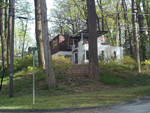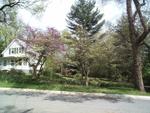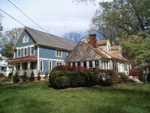
Poetry Prose and Other Words
by Ken Ingham
home
- poems - essays
- autobio - retroblog
music - reading - other - Gaia
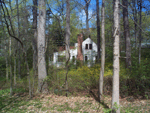
Yeandle house - a developer's dream
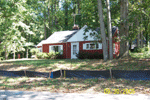
Fenimore house - scheduled for demolition

Joe & Betsy White house, circa 1950, and below, the same space from
a different angle in 2005
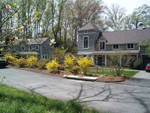
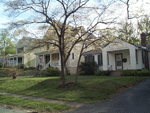
Two new houses replaced the Murtaugh house; the Chevy House on the
right is overshadowed by the hight of its new neighbor
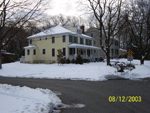
Two new houses where the Tinsley house used to be
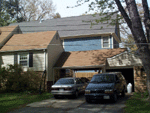
Tall box in what was once the backyard of a funky bungalo
for more photos go to Garrett Park Conservation Trust
Historical
quote from the
Smithsonian
The End of Funk
funky1 sl. 1 (esp of jazz or rock music) earthy, bluesy, with a heavy rhythmical beat. 2 fashionable. 3 odd; unconventional. 4 having a strong smell.
(from the Readers Digest Oxford Wordfinder)
This late-afternoon walk on a sunny autumn day in 2002 will begin like the dozens - no hundreds - of our walks before it. My wife Glenda and I will step off our porch onto a kaleidoscope of fallen leaves - tulip tree, hickory, Japanese maple, red and white oak. We will splash through them out onto the street and begin yet another tour of Garrett Park, our community, where houses acquire names and evening twilight comes early because of so many trees. Neighbors will be raking and blowing the leaves into sprawling piles which tend to narrow the streets to one lane this time of year. We will wave to some neighbors, stop and chat with others. I'll scratch behind the ears of their dogs. Glenda, who served as town clerk for twenty-five years, will likely get into a long conversation with one of her many acquaintances. I will beg to be excused and head for Porcupine Woods, one of my favorite places to brood. I know this is how our afternoon will unfold because it's been this way for over thirty years. Season after season, Glenda and I have meandered through the passages of Garrett Park, noticing the rhythm and changes in our little town, a place that might sound to you like some back country village but is instead an enclave nestled in suburban Maryland, not far from a major artery and just thirty minutes from downtown Washington, D.C. www.garrettparkmd.gov
We start down Rokeby Ave and pause to gaze at the facade of the small brick cottage next door. An elegant second story with several dormers was recently added onto the house. I ask Glenda how she likes it. "Funky" she says. "I'm so glad they didn't tear it down and build one of those Jeremy houses." She was referring to the dozen or so houses built in recent years by a resident developer who grew up in town. "At least I still have a nice view from my kitchen window." This is true. The mansionization that is occurring in Garrett Park has yet to affect us directly, but its just a matter of time. The increasing demand for ever larger homes is transforming communities all over the Washington area and several houses on our block are ripe for demolition. I have the feeling that if the trend continues, the nature of our walks and the funky nature of our town will be vastly altered.
Garrett Park was established in the 1890's on a couple hundred acres of open farm land adjacent to the B&O Railroad, about half way between Silver Spring and Rockville. Its namesake, Robert Garrett, president of B&O, promised the original developers extra trains and free daily delivery of up to 60 pounds of freight. An 1887 brochure assured home-seekers and investors that they could "confidently count on rapidly increasing value". By 1891, a half dozen three-story Victorian style "cottages" had been built. More followed. A variety of native trees, some still standing, were planted along the winding streets. By 1924 the population had swelled to over 200, most of them living in large homes. That same year, a syndicate of retired WWI veterans set out to mass produce smaller homes in order to make the amenities of Garrett Park affordable to "military people and others of modest means". "What about our property values?" cried the new Victorians. But progress prevailed and some fifty tiny houses were sprinkled around the town. They came with an option to include in the purchase a brand new Chevrolet, all for less than $6000. Many of these "Chevy" houses have been modified but some are still recognizable by the tell-tale arch above the entrance to the small porch.
After WWII there was a huge demand for housing all over the country and much of the open space in Garrett Park was taken up with a variety of individually tailored homes, not too many of any one style. These included the "Richter houses", a varied collection of "contemporaries" concentrated on the south side of town. By the time Glenda and I arrived in 1972 there were only a few vacant lots and most of those have since been occupied. Rising property values, the scarcity of vacant lots and a growing preference for interior space now make it profitable for local developers to demolish some of the funkiest houses in town and replace them with one or two new ones whose primary distinction is their enormity. Thus began "the age of Jeremy". Although Jeremy isn't the only developer in town, he's the most active, the focus of much community angst.
At the bottom of the hill, Glenda and I turn left through the pedestrian passage where Kenilworth dead-ends at Rokeby. On the left is the Yeandle house, a simple white cinder block that sits on two buildable lots, a developer's dream. The house is barely visible behind a jungle of invasive bushes and vines -- multiflora rose, honeysuckle, porcelain berry -- you name it. These grounds haven't been touched with anything sharp since the Yeandle's moved in twenty years ago. You might say the place has gone to the birds, which is exactly what the Yeandles intended. A wood thrush still nests perennially in their back yard, which is catty corner to our own and filled with trees including a red oak with a circumference of 11 feet. I often saw the Yeandles on their back porch, one having called to the other "Bring the binoculars". Sometimes they wandered off the patio on a narrow path through a lawn of English ivy, another invasive vine that looks great on university walls but gradually spreads and unchecked will eventually conquer the tallest of trees. All this greenery makes for ample privacy and a pleasant view from the side windows of our own house. Fortunately, Mrs. Yeandle, recently widowed, does not want to sell to a developer. She would prefer to leave the place as a sanctuary for birds or convert it to a playground for children, of which she has none.
In contrast, the Fenimore house, next door to the Yeandle's and directly behind our own, is surely destined for demolition. If we're home when it happens, we'll have a great view of the wrecking. How many times have Glenda and I watched through the trees from our own back porch or dining room window as the sun sank over this modest single-story home with red cedar siding. At least one family of renters in town would have loved to purchase it after Mr. Fenimore's death, but they couldn't compete with yet another resident developer, a recent arrival who lives in a fire-damaged Victorian that he restored, doubling its size in the process. We wonder if the house that replaces the Fenimore's will be as large as that. Sometimes we lounge in bed and imagine the occupants of the new house looking down at us from a third story window. This makes us want to lounge more often, while we still can without pulling the shade. But from where we now stand, in front of the Fenimore house on Kenilworth, the back of our own house can be glimpsed at a distance through the trees. We admire it and agree that the "Ingham" house, looks quite funky from this angle.
What exactly is meant by the word funk when applied to a house? Funk is such a subjective quality, and quality, as Robert Pursig expounded in Zen and the Art of Motorcycle Maintenance, is elusive and hard to define. Yet I believe most people recognize funk when they see it. I bet that if you asked ten people to pick out the ten funkiest homes in Garrett Park, there would be considerable overlap in their choices, choices that would speak to the unique shape of the house, its footprint, its roof lines, its facade and its setting. I also bet that most of the "winners" would be older homes. That's not to say a new house can't be funky but it isn't very common; funk happens more often by accident than by design, as different occupants find creative ways to satisfy their needs for extra space through additions and modifications. This has happened to many houses in Garrett Park, including some of the Chevy houses and Victorians.
One of the quaint aspects of living in a true community like Garrett Park is the way houses acquire the names of families that occupy them for many years and retain those names long after those families move. When the Payne's moved to the south side of town in 1948, they sold their first house, half way up the sledding hill on Argyle, to the Howard's from Takoma Park. But it took many years and a funky California-style flat-roofed second-story addition before that house became known as the Howard house. Even now, half a century later, the Howard's sometimes proudly refer to their house as the old Payne house. Everyone admired George and Norah Payne, legendary stalwarts in the community. George organized the do-it-ourself community swimming pool construction project and served more than 20 years as councilman or mayor, while still finding time to render his new home progressively more livable with multiple additions. He passed away in 1999. Nora, a major force in the women's club, has moved to a nursing home. Part of their legacy is that their funky multifaceted house, if it survives, will retain its name for a long time. But if demolished and replaced by a mansion, its capacity to remind will vanish and so, that much faster, will our memory of the Paynes.
That's what happened across the street from the Fenimores and Yeandles where once stood the Joe and Betsy White house, perhaps the funkiest ever in Garrett Park. It was built on the foundation of the original farm house, next to a trickle of a stream, just wet enough to harbor a few amphibians. The house was shaded by two huge tulip trees that probably sprouted before the town was conceived. According to local lore, Betsy kept more than a dozen cats who perched on the sills of various unclosed windows and slunk around the undergrowth. I recall how the yard sloped away from the street so that passers-by actually looked down on the roof and into the windows of the small dormer. No more. That house, together with the big trees, was demolished almost ten years ago to make room for two much larger and taller "Jeremy" houses. The trickle was viewed as a drainage problem and converted to an underground storm sewer. Perhaps that was the beginning of the end of funk in Garrett Park. An alternative would have been to preserve the trickle and the trees and build one larger house, or better yet, renovate and enlarge the existing one on its historic foundation. Eventually, the Joe and Betsy White house could have qualified for grand national funk status.
By contrast, most of the new houses of the current era will never qualify. Architectural distinctions between them are often superficial; a dormer here, some scallops there, porch on the left vs. on the right or all the way across. The minor differences go unnoticed as the eye is overwhelmed by the sheer size of these looming rectangular rhombohedrons. Instead of working with a creative architect to design an intriguing house that suits the landscape and blends into the neighborhood, most modern developers reach into a small drawer of plans and choose whichever model provides the maximum allowable square footage for the size of the lot, leaving no room for future funky additions. If some trees happen to be in the way, they just include them in the demolition; you don't need a whole forest to have a clearcut. And if they overshoot on the square footage, not to worry; so far the town has lacked the will or resources to enforce the restrictions.
Glenda heads home and I make my way toward Porcupine Woods, several acres of recovering upland forest that the town purchased in the late 1970s. I step off the street onto a spongy trail of wood chips, as soothing to the asphalt-tenderized soles of my feet as the colorful canopy is to the troubled soul of my existence. Just inside the woods I pause between two of the largest tulip trees remaining in town. The intensity of yellow in their tops seems exceptional this year. I glance over my shoulders, then give them each a hug. Trees. I love them, not only for their beauty and poise but for the services they provide, the ways in which they contribute to community funk. Our distant ancestors lived in trees and some of our distant but genetically similar cousins still do. The presence of trees has been documented to reduce stress in humans. Trees provide feeding and nesting sites for birds who in turn fill the air with soothing songs. Trees produce seeds and nuts that nurture squirrels, whose antics entertain us and attract the attention of hawks and owls. Occasionally the trees in Garrett Park are bejeweled with ice, sparkling and crackling in the January sun. Their trunks cast long moon shadows on fresh snow. Trees generate oxygen and purge the air of pollutants. They cool our streets and homes in summer, shelter us from harsh winter winds, shed leaves for mulch and limbs for firewood. And, most relevant here, mature trees affect the quality of light falling on a house, reducing harsh glare from glazed surfaces, rendering a softer funkier ambience. Why would anybody cut them down unnecessarily?
Not everybody would. Growing awareness of their benefits has led to increased efforts on the part of some communities to thwart the reckless destruction of trees and promote the planting of new ones. Washington D.C. has recently vowed to increase its foliage cover from 30 to 35%, still short of the optimum of up to 60% recommended by americanforests.org, a nonprofit group that promotes the reforesting of both rural and urban communities. Some cities, especially in Europe, have actually begun to reforest the tops of buildings. Meanwhile, Garrett Park is going in the opposite direction. I've suffered more than one cramp in my neck by staring up past our newest roofs into gaping holes in the canopy, holes larger than would have been necessary had the new houses been fewer or smaller or differently shaped so that trees could have been spared.
Of course, having a few large houses scattered throughout the town is not the end of the world. The original Victorians were also quite large for their time and bore a stylistic similarity. But I invite you to come to Garrett Park and stop in front of the two yellow monsters that recently replaced the well-shaded Murtaugh home at 10916 Cleremont and visualize a whole row of them stretching from Strathmore down the hill to Porcupine Woods. Or look south down Montrose from the corner of Oxford where the solid brick Tinsley house was replaced by two frame boxes and imagine them proliferating all the way to the dead end at Parkside. These are not far fetched scenarios. A friend of mine who lives in town was insulted when informed by Jeremy himself that he was living in a "knockdown", real-estate jargon for a house that could profitably be replaced by a larger one, or two. There are many such houses in Garrett Park, destined for demolition if the current trend prevails. A few more years and our town will be irreversibly altered - fewer trees, less shade, more asphalt, less architectural variety, and certainly less funk.
Is it possible to accomodate the demand for larger houses and still preserve the funky nature of Garrett Park? The fact that we live in an incorporated municipality with an elected mayor and council gives us some potential control over our future. If we can't stop rampant mansionization who can? The town council, in response to an outcry from concerned citizens, took a bold step in 2001 by passing a six-month moratorium on demolition to allow the people to catch their breath and discuss what was happening. Jeremy reportedly was so angry that he had to be escorted from the council meeting. Soon after the moratorium he squeezed a tall skinny blue box into the back yard of a once funky bungalow that now appears tiny and out of place, the formerly pleasant vista from its rear windows obscured by a three story wall just twenty feet away, the legal minimum in Garrett Park. That minimum is even lower in the county at large, for example in Bethesda, where mansions are separated by only 14 feet, a virtual alley.
On request from the town council, the historic preservation committee met several times to explore the possibility of tighter restrictions on the size and positioning of new homes. Thanks to former mayor Peggy Pratt, Garrett Park was listed on the national register of historic places two decades ago. Several older homes are designated as historic sites and any changes to them must be approved by Montgomery County officials. Extending those protections to the entire town is not a popular idea. People fear that it would lead to over-regulation, with every change in or addition to any home having to be approved by a cumbersome bureaucracy. And after all, additions do foster funk. A more flexible alternative might be to place restrictions on the overall square footage of impermeable space including driveways and garages and on the height of any new house relative to that of its neighbors, and perhaps also on the removal of trees beyond a certain size.
Some of the trees in Garrett Park are older and funkier than any of the houses. They should be viewed as part of our historic character and be protected from unrestricted cutting. Laws to that effect have been passed in hundreds of communities, including many municipalities in Maryland. In nearby Takoma Park, property owners must secure a permit before cutting any tree with a circumference greater than 24 inches. Garrett Park already regulates the trees on town right-of-ways through a turn-of-the-century ordinance that makes it unlawful to "break, wound, destroy . . . or injure" any of the public trees and shrubs. Widening that ordinance to cover privately owned trees could induce builders to design around them, producing a greater variety of foot prints and roof-lines, each home a distinct architectural statement that blends the human with the natural. The resulting homes would be unique in character, still expensive, perhaps more so than a box, and possibly even more profitable, not because of their size but because of their absolute elegance -- funk by design, instant upscale funk!
Another approach to checking the spread of mansionization is through promotion of private conservation easements, usually held by a land trust or by the county or state. This approach has been widely used to preserve forest and agricultural land and is beginning to spread to urban settings. It provides a mechanism whereby individuals, such as Mrs. Yeandle, who want to voluntarily limit future development on their property can do so by giving an easement in which the limits are spelled out. Although such restrictions will usually diminish the "value" of the property vis-a-vis what it could bring from a developer, the diminution in appraised value may qualify as a charitable gift for income tax purposes, providing partial recoupment for the owners. The Garrett Park Conservation Trust was recently formed for the purpose of accepting, monitoring and enforcing such easements.
A point that is often raised in opposition to restrictions of any kind is that of "property rights". Some people feel they should be allowed to do whatever they wish with their property, as if they were homesteaders in the wilderness. But governments have long regulated civil behavior. The very incorporation of Garrett Park in 1898 was motivated by the desire of the majority to preclude the installation of indoor plumbing in the infamous and recently enlarged Grace E. D. Sprigg house at 4710 Waverly Avenue. Neighbors were justifiably concerned about the potential impact of her septic field on their drinking water. Eventually of course, indoor plumbing prevailed, followed by a sewer system that shunts all human excrement to a remote location, out of sight and mind. Too bad, in a way. If communities like Garrett Park had decided a century ago to limit population density by requiring that each household properly mulch and dispose of its own waste on site, there would not be a shortage of green space.
On my way home from Porcupine Woods I take a noisy leaf-strewn shortcut through Wells Park, a small playground where children occasionally swing and slide beneath a canopy of mature deciduous trees that tower over one of the last exposed streams in town, a tributary of the not-to-distant Rock Creek. The park is located on land generously donated in 1934 by Alton Wells, a former resident builder and 4-term council member who built the Joe and Betsy White house and the Yeandle house. I think about the foresight and efforts of past citizens to improve, protect and sustain this community. If it weren't for Mayor George Fitzpatrick and his contemporaries, we wouldn't have our Porcupine Woods - it would have been replaced with townhouses twenty years ago. If not for Mayor Peggy Pratt, we wouldn't be on the national register of historic places. Nor would we have the overlay zoning system that already imposes greater setbacks and goes farther than Montgomery County to limit the square footage of a lot that can be covered by a house. The history of Garrett Park is studded with magnanimous acts by thoughtful and caring people. Now their collective legacy is severely threatened by a new generation of developers who exploit what has been historically preserved in this rare community.
I leave Wells Park and start up the long Rokeby hill towards home, my pulse already quickened by such contemplation. I find myself scrutinizing every house I pass. There isn't one that couldn't be improved with a funky addition. Instead of knocking down and building new, why not enlarge and upgrade the existing structures, add some bricks and stone, a dormer or two, transform each one into a work of art, inside and out. Wouldn't it be fun!
Demolition is such an awful waste of natural resources and past human labor. It makes my heart ache to see all those studs, rafters and joists being hauled away to the land fill. If new lumber were priced at its true value, if the harvesting of it wasn't subsidized so heavily with federal tax dollars, such an approach would not be profitable. The day will come, perhaps in my lifetime, when forests are so diminished that builders will be compelled to recover and re-use every piece of lumber in a demolished home. By remodeling instead of demolishing and building anew, Jeremy could be ahead of the curve, leading us into that sustainable future that everyone is hoping for. Why not take Garrett Park all the way upscale, to something rich and textured, so that when our children and grandchildren return to visit, they will marvel at the uniqueness of this town, changed but forever funky, filled with elegant Jeremy houses, still covered with trees.
